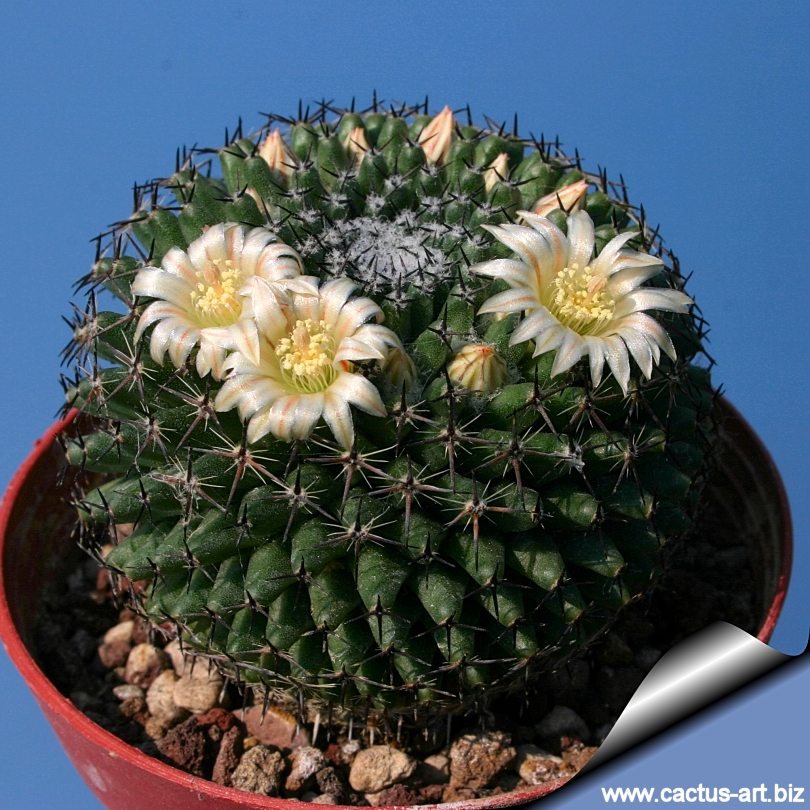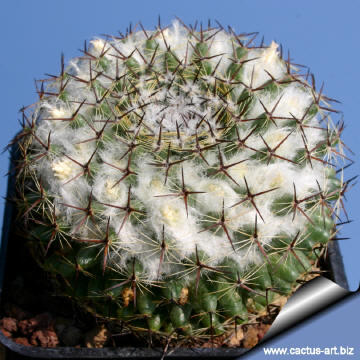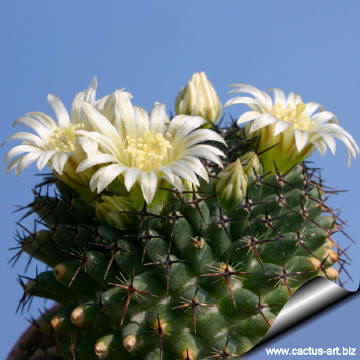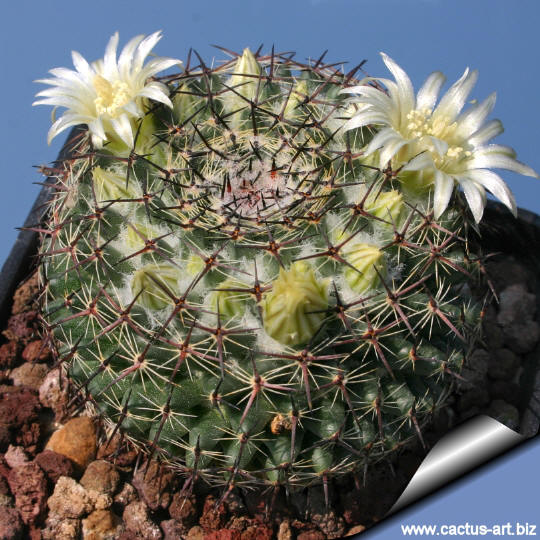|
|
|

Mammillaria formosa
This
Mammillaria gets only better looking
with age. It will continue to put on more and more heads, as well as
more white cotton topping.
|
|
Description: Plants solitary, sometimes clumping dichotomously with
age (occasionally ramifies , producing a basal shoots) . Given enough
time, M. Formosa will form mounds. Old plants with lots of
branching are treasures. This plant variation is huge, the spine length,
the wool covering and appearance varies from clone to clone.
Stem: Symmetrically globose at first, later cylindrical, with a
depressed apex, 5 - 20 cm high, up to 10 (or more) cm in diameter. Light
green,and may, with age, become rubberized at its base
Tubercles: Crowded, pyramidal, with latex, arranged in numerous,
very close-set spirals. The Axil is woolly with white wool especially in
the floriferous portion.
Areoles: Oval and woolly when young.
Roots: Fibrous.
Radial spine: 20 - 22, sometimes absent, thin, needle- or
bristle-like, sometimes flattened, somewhat horizontal radiating and
arranged laterally on each side of the tubercle, white, 3 - 6 mm long.
Central spine: 4 - 7, usually 6, pinkish to brown with darker
tips, to 8 mm long.
Flower: Diurnal, funnel-form,
dull white to light pink about 10 - 15 cm in diameter.
Blooms adorn the crown of the plant,
usually in a ring, in the growth of the previous
year.
Blooming seson: Spring to summer.
Fruit: Attractively deep dull pinkish-red coloured .Club-shaped.
Seed: Light brown.
M. formosa is a very variable
species, and some of the different growing forms have for a long time
been considered separate and distinguished subspecies, for example:
subsp. formosa: It has 20-22 radial spines and pink
flowers. Origin: oahuila, Aguascalientes, Guanajuato, Zacatecas,
Tamaulipas, Nuevo Leon and San Luis Potosi.
subsp. microthele: It has 22-24 bristly, flattened spines
with white flowers. Origin: Cohahuila, Guanajuato, Tamaulipas and San
Luis Potosi. This form should be grown conservatively to preserve the
flat habit that is present in the wild.
subsp. pseudocrucigera: It has about 18
radial spines, (sometime lacking in mature areoles) the blooms are pink
with paler margins. Origin: Queretaro, Guanajuato.
|
 |
 |
|
Mammillaria formosa has very teensie
spines that lie flat against the plant so not that dangerous
(still can get you if not careful, though).
The white wool
between the areoles makes this species a pleasure to look at and grow,
but the diversity among individual specimens is considerable and the
best plants have abundant white axillary wool. Hence, it is worth
raising a batch of seedlings and selecting one or two that have the most
wool. |
|


Advertising
|
|
|
|
|
Family:
Cactaceae
(Cactus
Family)
Scientific name:
Mammillaria formosa ssp.
formosa Galeotti ex Scheidw.
In: Bull. Acad. Sci. Brux. 5: 497
(1838)
Origin: Mexico (Coahuila,
Aguascalientes, Guanajuato, Zacatecas, Tamaulipas, Nuevo Leon and San
Luis Potosi) Altitude 960 - 2.350 m.
Common Names include: "Owl Eyes" and "Royal Cross"
Conservation status: Listed in
CITES appendix 2.
Synonyms:
- Mammillaria microthele
Muehlenpfordt
Published in: Allg. Gartenz.
16:11 (1848)
- Mammillaria formosa ssp.
microthele (Muehlenpfordt) D.R.Hunt 1997
- Mammillaria pseudocrucigera
R.T.Craig 1945
- Mammillaria formosa ssp.
pseudocrucigera R.T.Craig (D.R.Hunt 1997)
- Mammillaria arroyensis
Reppenhagen 1989A
NOTE: At a first
glance some forms of M. formosa may be confused with
M. sempervivi, but it is not so difficult to distinguish,
especially when in flower. M. sempervivi has very few
radial spines and they soon drop off, leaving just 1 or 2 central
spines. The flowers also are quite definitely yellow. Formosa and its
various forms, usually have persistent radial spines, usually 2 to 6
central spines, and pale pink to white flowers. The only plant that
differs in M. pseudocrucigera, often stated to be a form
of sempervivi, but this has pink striped flowers, though
its spines are more like the proper sempervivi. Pilbeam
says that ssp. pseudocrucigera is the link between formosa
and sempervivi.
|
|
|
|

This is one of the Mammillaria commonly called "Owl Eye
Cactus", known for
dichotomous branching (forking or dividing into two parts). Although
dichotomous branching is not a common occurrence in cacti in general, it
happens for some reason in this particular species. What
is interesting about this cactus is that it began as a single head, and
it has now divided twice, forming what will be four separate branches.
When the division process started, it was obvious that four heads would
appear, but I don’t think the one head divided quadruply. Most probably,
one head became two, and then those two immediately divided.
Other Owl Eye Cactus among others comprise:
M. karwnskiana,
M. microthele,
M. tlalocii and
M. perbella.
Cultivation: It is easy to
cultivate and make interesting specimens for any collection,
and over time (in 12-15 years) it will form enormous colonies up to 50
cm or more in diameter!
It grows by dichotomously dividing,
and also by producing offsets, and doesn't
require any special treatment, except
for the need for frequent transplanting,
in order to manage its exuberance. It needs as
much light as possible without burning the plant,
to keep the stems compact. Provide a well-drained soil mix.
Water well and then allow to dry thoroughly
before watering again during the growing season. It doesn't
like much, if any, winter water, but can survive
short exposures to freezing temperatures (-4° C.) if properly hardened
off and kept dry.
Propagation: Mammillaria formosa is best propagated
from seed. Seed readily germinates at 20°-22°C,
or by offsets if available. |
|
Photo of conspecific taxa, varieties, forms and
cultivars of plants
belonging to the
Mammillaria formosa
complex
(This
Taxon
has lots of synonyms (
like many other cacti) whit
several controversial varieties and subspecies and comprises a
multitude of different forms, but where each form is linked to others by
populations of plants with intermediate characteristics):
|
|